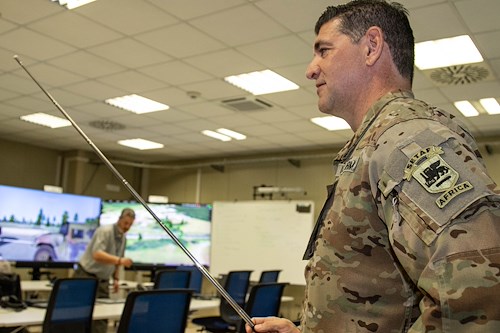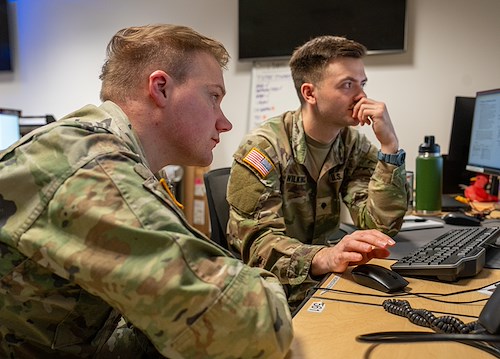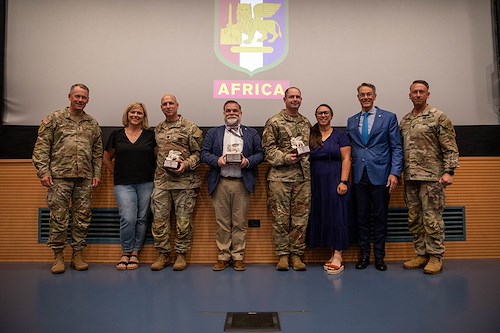Gallery contains 7 images
×
Photo 1 of 7
U.S. Army Southern European Task
U.S. Army Chief Warrant Officer 5 Al Santillan, safety office deputy director, U.S. Army Southern European Task Force, Africa (SETAF-AF), provides instruction at the inaugural meeting of the safety collaboration group (SCG) at Caserma Ederle, Vicenza, Italy, Oct. 10, 2024. U.S. Army Maj. Gen. Andrew C. Gainey, commanding general of SETAF-AF, charged his safety office with establishing a SCG, with the primary responsibility to consolidate best practices for risk management and accident prevention. (U.S. Army photo by Maj. Joe Legros)
Photo by: Maj. Joe Legros
Photo 2 of 7
U.S. Army Southern European Task
Safety instructors with the U.S. Army Southern European Task Force, Africa (SETAF-AF) safety office demonstrate the risk reduction benefits of the Virtual Battle Space 3 system at the inaugural meeting of the safety collaboration group (SCG) at Caserma Ederle, Vicenza, Italy, Oct. 10, 2024. U.S. Army Maj. Gen. Andrew C. Gainey, commanding general of SETAF-AF, charged his safety office with establishing a SCG, with the primary responsibility to consolidate best practices for risk management and accident prevention. (U.S. Army photo by Maj. Joe Legros)
Photo by: Maj. Joe Legros
Photo 3 of 7
U.S. Army Southern European Task
Safety instructors with the U.S. Army Southern European Task Force, Africa (SETAF-AF) safety office demonstrate the risk reduction benefits of the Virtual Battle Space 3 system at the inaugural meeting of the safety collaboration group (SCG) at Caserma Ederle, Vicenza, Italy, Oct. 10, 2024. U.S. Army Maj. Gen. Andrew C. Gainey, commanding general of SETAF-AF, charged his safety office with establishing a SCG with their primary responsibility to consolidate best practices for risk management and accident prevention. (U.S. Army photo by Maj. Joe Legros)
Photo by: Maj. Joe Legros
Photo 4 of 7
U.S. Army Southern European Task
A safety instructor with the U.S. Army Southern European Task Force, Africa (SETAF-AF) safety office poses for a photo of his uniform’s safety patch at the inaugural meeting of the safety collaboration group (SCG) at Caserma Ederle, Vicenza, Italy, Oct. 10, 2024. U.S. Army Maj. Gen. Andrew C. Gainey, commanding general of SETAF-AF, charged his safety office with establishing a SCG with their primary responsibility to consolidate best practices for risk management and accident prevention. (U.S. Army photo by Maj. Joe Legros)
Photo by: Maj. Joe Legros
Photo 5 of 7
U.S. Army Southern European Task
Safety instructors with the U.S. Army Southern European Task Force, Africa (SETAF-AF) safety office lead a presentation at the inaugural meeting of the safety collaboration group (SCG) at Caserma Ederle, Vicenza, Italy, Oct. 10, 2024. U.S. Army Maj. Gen. Andrew C. Gainey, commanding general of SETAF-AF, charged his safety office with establishing a SCG, with the primary responsibility to consolidate best practices for risk management and accident prevention. (U.S. Army photo by Maj. Joe Legros)
Photo by: Maj. Joe Legros
Photo 6 of 7
U.S. Army Southern European Task
Safety instructors with the U.S. Army Southern European Task Force, Africa (SETAF-AF) safety office demonstrate the risk reduction benefits of the Virtual Battle Space 3 (VBS3) system at the inaugural meeting of the safety collaboration group (SCG) at Caserma Ederle, Vicenza, Italy, Oct. 10, 2024. U.S. Army Maj. Gen. Andrew C. Gainey, commanding general of SETAF-AF, charged his safety office with establishing a SCG with their primary responsibility to consolidate best practices for risk management and accident prevention. (U.S. Army photo by Maj. Joe Legros)
Photo by: Maj. Joe Legros
Photo 7 of 7
U.S. Army Southern European Task
Safety instructors with the U.S. Army Southern European Task Force, Africa (SETAF-AF) safety office demonstrate the risk reduction benefits of the Virtual Battle Space 3 system at the inaugural meeting of the safety collaboration group (SCG) at Caserma Ederle, Vicenza, Italy, Oct. 10, 2024. U.S. Army Maj. Gen. Andrew C. Gainey, commanding general of SETAF-AF, charged his safety office with establishing a SCG, with the primary responsibility to consolidate best practices for risk management and accident prevention. (U.S. Army photo by Maj. Joe Legros)
Photo by: Maj. Joe Legros
VICENZA, Italy – Safety goes beyond individual responsibility—it is about learning from shared experiences and working together to uphold best practices.
To codify this principle, U.S. Army Maj. Gen. Andrew C. Gainey, commanding general of U.S. Army Southern European Task Force, Africa (SETAF-AF), charged his safety office with establishing a safety collaborative group (SCG) within the Vicenza Military Community. The primary responsibility of the group is to consolidate best practices for risk management and accident prevention.
At its inaugural meeting on Oct. 10, the SCG brought together safety officers from across the command, including the 173rd Airborne Brigade, the 79th Theater Sustainment Command, the 2nd Security Force Assistance Brigade and the 414th Contracting Support Brigade.
In his welcome address, David Jones, SETAF-AF deputy chief of staff, stressed the significance of the new initiative.
"Soldier, civilian and family safety is important," he said. "We just want to take care of people and it all comes down to safety. At the places we work and live, so many incidents can be prevented when we first think through the safety concerns."
Proper maintenance of vehicles, equipment or weapon systems not only eliminates “down time,” it also lowers the risk to people operating the equipment. SCG members agreed that training, education and collaboration reduce those hazards even further.
“Even the temporary loss of a critical piece of equipment directly impacts the success of a mission,” said Chief Warrant Officer 5 Al Santillan, the deputy director of SETAF-AF’s safety office. “And it’s not just equipment; our people are the most critical component we need to protect.”
In response to the growing need for more effective safety training, the military has been exploring new ways to simulate real-world hazards and teach soldiers how to respond appropriately. Santillan conducted a demonstration of one of the latest technological advances at the SCG meeting, the Virtual Battle Space 3 (VBS3) system.
The VBS3 simulates convoy operations, forward observation, land navigation, range safety and more, providing soldiers with the tools they need to stay safe and successfully complete their missions. With these advancements, SETAF-AF hopes to reduce the number of safety-related incidents inherent during training events, as well as on the battlefield.
"Safety is the focus of this simulation, but obviously the system has other useful applications,” Santillan said. “Any vehicle can be programmed into the system. The maps are real-world, and you can also inject other items like heavy traffic areas, pedestrians, adverse weather such as rain, wind or snow, as well as specific maintenance issues."
The approach allows users to learn from past mistakes by recreating hazardous situations in a controlled environment.
“It’s also an opportunity for leaders to provide immediate feedback and thorough after-action reviews, allowing soldiers and leaders to see exactly what went wrong and how to fix it,” said Steve Boyd, SETAF-AF safety director.
While this initial meeting touched on how new technology increases soldier safety, future meetings will focus on a variety of topics meant to leverage best practices. The safety group’s next step includes conducting the first Safety and Occupational Health Advisory Council Dec. 4, chaired by SETAF-AF’s commanding general.
Representing Gainey, Jones expressed optimism the newly formed group would lay the foundation for future safety initiatives.
"Thanks to everyone for being here. My hope is that this initial meeting is the spark that keeps everyone safe into the future," he added.
About SETAF-AF
SETAF-AF provides U.S. Africa Command and U.S. Army Europe and Africa a dedicated headquarters to synchronize Army activities in Africa and scalable crisis-response options in Africa and Europe.

























